Hair Care Routine for Straight Hair: Steps, Products & Expert Tips
Hair care routine for straight hair is a topic of growing importance. You’re not alone in seeking answers—over 30-40% of people have naturally straight hair, including an estimated 86.6% of Chinese and 84.3% of Japanese women (clinical study on straight hair prevalence, market statistics on hair care).
With the hair care market poised to hit an astounding $88 billion by 2028 and $118 billion by 2030—expanding at a compound annual growth rate of 6.72% annually (up-to-date hair care market data)—interest in tailored and sustainable hair routines is booming.
The importance of a customized hair care routine for straight hair cannot be overstated, as tailored care helps keep straight locks sleek, healthy, and full of life. If you’re curious about how our hair connects to self-expression and self-worth, the idea that hair is the crown you never take off—let’s talk about it—because hair choices carry powerful cultural and personal meanings.
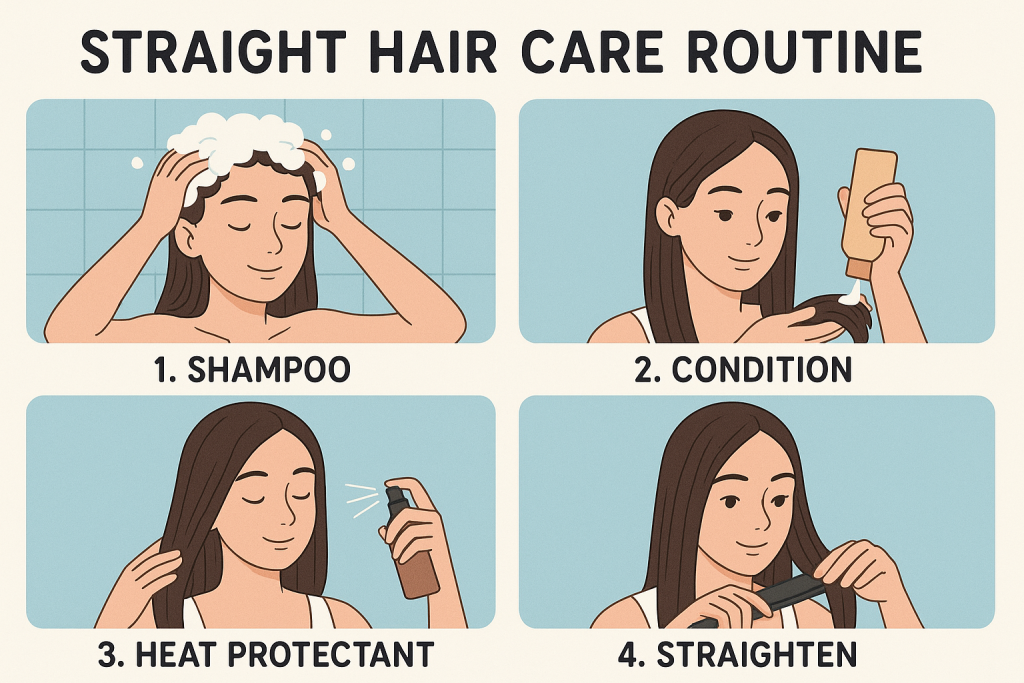
Understanding Straight Hair: Structure and Needs
Straight hair care begins with understanding the unique biology of this hair type. The cuticles of your hair shaft lie flat and snug against each other, resulting in the smooth surface straight hair is known for. For a more nuanced view, hair cuticle alignment explained reveals how microscopic differences shape everything from strand strength to shine resilience. This structural trait allows straight hair to reflect light more evenly, contributing to its signature shine. But there are vulnerabilities, too.
“Straight hair’s aligned cuticle structure allows sebum (your scalp’s natural oil) to travel down the hair shaft much more efficiently,” says Dr. Maria Hordinsky, Professor in the Department of Dermatology (hair disorders).
This efficient oil distribution is a blessing and a curse—while it naturally conditions the hair, straight hair can look oily faster. Straight hair also grows faster in some populations; for instance, Asian hair grows approximately 1.3 cm per month compared to Caucasian hair’s 1.2 cm and African hair’s 0.9 cm (hair growth comparison by hair type).
Interestingly, not all hair types experience these factors the same way; those managing spirals might relate to unique issues discussed in a dedicated curly hair routine, highlighting key contrasts in daily care approaches.
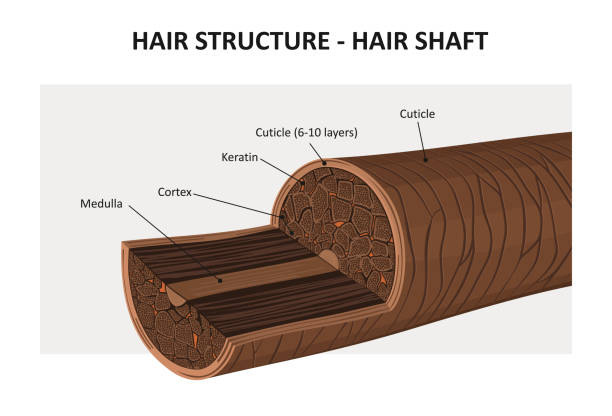
- Has more efficient oil distribution (sometimes excessively so)
- Displays damage more visibly (split ends and breakage are harder to hide)
- Is prone to appearing flat and limp with heavy product use
- Tends to collect pollutants more readily on the hair shaft
- Requires frequent washing due to faster oil buildup
While genetics primarily determine hair type, environmental and lifestyle factors also play a crucial role in healthy straight hair. For example, only 2% of straight-haired people in India report stress-related hair issues, compared to 37.4% in Japan (study on stress and straight hair).
For those who have noticed dramatic shifts due to hormonal, environmental, or stress factors, there’s growing research into straight to curly hair texture change, showing how hair texture may evolve over time.
Copying routines suited to wavy or curly hair may cause straight hair to look flat and greasy or lead to breakage. Instead, the right straight hair care approach tailors products, wash schedule, and techniques to these unique structural needs.
In this context, it’s also important to recognize the subtle forms of curly vs straight hair texture discrimination that shape mainstream hair care narratives, influencing which routines flourish and which are overlooked.
Step-by-Step Daily Hair Care Routine for Straight Hair
To maintain healthy straight hair, a woman needs a daily hair care routine that combats quick oil buildup, prevents dryness, and manages static without weighing hair down. The hair care routine for straight hair must be adaptable for both wash days and non-wash days.
Here are clear, actionable steps for the ideal routine, while keeping in mind that even with straight hair, achieving volume for fine hair through particular hairstyles may dramatically shift your hair’s perceived thickness and fullness.
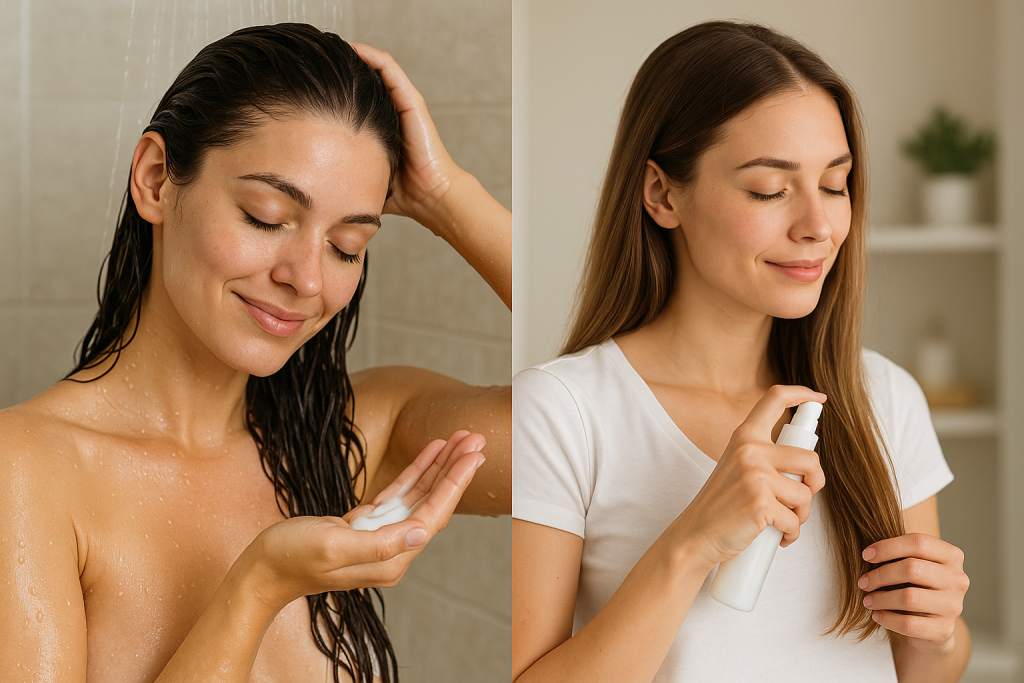
Step 1: Cleansing – Choosing the Right Shampoo
- Opt for sulfate-free formulations labeled “balancing,” “volumizing,” or “lightweight.”
- Massage shampoo into the scalp with fingertips (not nails), focusing on the oil-prone crown and hairline.
- Rinse thoroughly with lukewarm water to prevent excessive oil production.
Sustainable alternative: Try shampoo bars with natural clarifying ingredients like nettle and rosemary. Many cruelty-free brands use eco-friendly packaging, supporting the broader movement towards eco-friendly hair products for a sustainable future, which aims to reduce the environmental impact of our daily routines.
“Straight hair benefits from sulfate-free formulations that gently remove oil buildup from the scalp,” says celebrity hairstylist Mark Townsend.
Step 2: Conditioning – Lightweight Moisture
- Apply conditioner only to ends and mid-lengths, avoiding roots entirely.
- Leave on for 1-3 minutes, then rinse with cool water.
Expert tip: “People with straight hair tend to over-condition and that’s the biggest mistake they can make,” says trichologist Anabel Kingsley.
- Use lightweight, water-based formulas sparingly—condition the oldest parts only (the ends).
- Once a week: apply a lightweight hair mask to the bottom third of your hair for 5-10 minutes. For an extra boost that won’t leave your hair limp or heavy, exploring the best leave-in conditioners for straight hair can reveal options ideal for shine without buildup.
Step 3: Detangling and Drying
- Use a wide-tooth comb or a wet brush made for straight hair. For the optimal experience and less breakage, it’s helpful to know what truly makes the best brush for straight hair—from bristle type to ergonomic design.
- Start detangling from the ends, moving upward in small sections.
- Be gentle—never tug wet hair, as it is at its most fragile.
- Pat dry with a microfiber towel or an old T-shirt. Air-dry whenever possible; straight hair shows heat damage quickly.
Step 4: Heat Styling Protection
- Use a heat protectant spray or serum before any styling.
- Pick silicone-free formulas to prevent buildup on straight hair.
- Hair should be at least 80% dry before blow drying or flat ironing.
- Keep flat iron temperatures under 365°F (185°C) and limit styling to 2-3 times per week.
- Choose high-quality ceramic or tourmaline tools for even heat.
“Straight hair doesn’t need as much heat to style as curly hair,” says hairstylist Jen Atkin. Lower your heat settings for less damage.
Step 5: Nighttime Protection
- Brush through hair with a boar bristle brush to distribute oils nightly.
- For long hair, style it in a loose, low braid to prevent nighttime tangling.
- Use a silk or satin pillowcase to minimize friction. Those who’ve struggled with hair creasing after wearing helmets may be surprised that helmet hair solutions for bikers can also benefit anyone battling overnight flattening or unexpected kinks.
- Never sleep with wet hair—this leads to tangling and breakage.
- Very fine hair? Try a loose top knot to boost morning root volume.
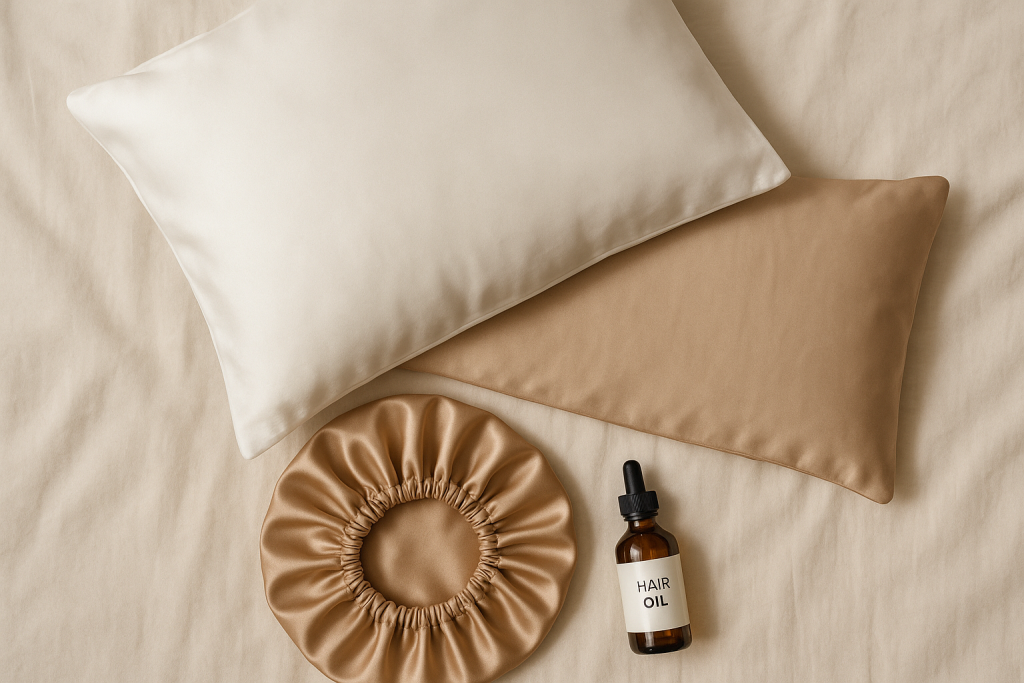
Recommended Hair Products for Straight Hair: Comparison Table
Building the best hair care routine for straight hair means choosing the right products that deliver lightweight moisture, enhance natural shine, and help control oil.
Here is a detailed comparison table to guide you through salon and drugstore options, with emphasis on sustainability and expert picks. If you’re passionate about animal welfare and ingredient purity, taking a deeper look at the best vegan hair care products can expand your product knowledge beyond traditional lines.
For an even broader selection spanning specialty formulas, don’t miss resources comparing the best vegan hair care products 2 and best vegan hair care products 3, which dive into performance and ethics alike.
| Product | Type | Key Features | Price Range | Eco-Friendly | Expert Rating |
|---|---|---|---|---|---|
| Bumble and Bumble Sunday Shampoo | Clarifying Shampoo | Weekly detox; Removes product buildup; Enhances shine | $$$$ | No | ★★★★★ |
| L’Oréal Paris EverPure Sulfate-Free | Daily Shampoo | Lightweight formula; Color-safe; Rosemary-infused scent | $$ | Partially | ★★★★☆ |
| Pantene Pro-V Silky Smooth Care | Daily Shampoo | Smooths frizz and roughness; Affordable | $ | No | ★★★☆☆ |
| Aveda Smooth Infusion | Conditioner | Plant-derived ingredients; Fights humidity; Lightweight | $$$$ | Yes | ★★★★★ |
| Olaplex No. 7 Bonding Oil | Oil | Strengthens, heat protection, lightweight | $$$$ | No | ★★★★★ |
| The Ordinary 100% Plant-Derived Squalane | Hair Oil | Single-ingredient, ultra-lightweight, versatile | $ | Yes | ★★★★☆ |
| Verb Ghost Oil | Hair Oil | Weightless, heat protection, adds shine | $$ | Partially | ★★★★☆ |
| GHD Platinum+ Styler Flat Iron | Tool | Adjustable heat, ceramic plates | $$$$ | Yes | ★★★★★ |
| Tangle Teezer The Original Detangling Brush | Tool | Easily glides through tangles, minimizes breakage | $$ | No | ★★★★★ |
| Mason Pearson Boar Bristle Brush | Tool | Natural bristles, distributes scalp oil | $$$$$ | No | ★★★★★ |
When shopping, look for product labels highlighting terms like “lightweight,” “volumizing,” or “thickening.” Fine straight hair benefits from ultra-light products without heavy silicones. Medium straight hair requires “balancing” or “normal” formulas with moderate oils.
For thick straight hair, opt for smoothing and anti-frizz shampoos with more conditioning agents. Brands like Aveda, The Ordinary, and Briogeo are committed to sustainability with refillable packaging and eco-conscious formulations.
If you want to ensure your whole routine is aligned with green values, consider exploring practical eco-friendly hair care practices that range from water conservation to biodegradable accessories. Even small adjustments—like switching to refillable shampoo systems—support a larger commitment, and you can discover additional techniques through eco-friendly hair care practices 2 and advanced strategies found in eco-friendly hair care practices 3 for reducing your environmental footprint.
“The best products for straight hair need to enhance the natural shine of the strands without weighing them down,” says celebrity hairstylist Adir Abergel.
Troubleshooting Common Straight Hair Issues
Straight hair may look effortless but it brings its unique set of challenges. Straight hair care routines need to solve issues around oiliness, limpness, frizz, and split ends. Here’s targeted advice for the most frequent complaints. For those with changing lifestyles or climate exposure, comparing how dynamics affect texture in wavy and curly types unlocks fresh strategies—sometimes even quick solutions, as discussed in quick curly hair products for on-the-go routines, where efficiency meets efficacy in hair management, inspiring crossover tricks for straight hair as well.
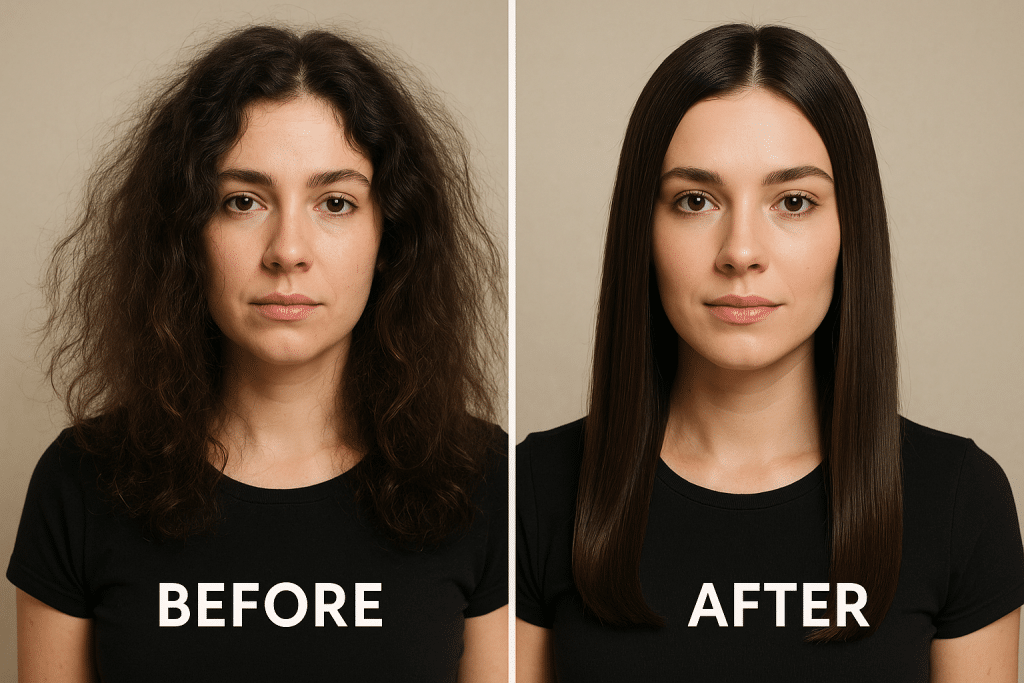
Problem: Excessive Oiliness
- Use a clarifying shampoo once weekly to remove buildup.
- Apply dry shampoo before oil appears (overnight).
- Train hair to go longer between washes gradually.
- Avoid touching your hair or applying products to the roots.
“Oil production is largely genetic, but can be managed,” advises dermatology experts.
Problem: Flatness and Lack of Volume
- Choose volume-boosting shampoos (keratin or rice protein extracts).
- Condition from mid-lengths to ends only.
- Use a root-lifting spray before blow-drying.
- Change partings regularly and try sleeping with a loose top knot.
Evidence shows that changing up your blow-drying technique (drying upside down) can increase volume in straight hair by up to 30%.
Problem: Static and Flyaways
- Use an ionic blow-dryer to neutralize static charges.
- Apply a small amount of lightweight hair oil to ends.
- Carry a dryer sheet for on-the-go smoothing.
- Use wooden or boar-bristle brushes, not plastic.
- Leave-in conditioner on ends helps control static.
“Static happens when electrons move between objects and opposite charges are formed,” says cosmetic chemist Perry Romanowski.
Problem: Visible Damage and Split Ends
- Trim hair every 8–12 weeks.
- Use bond-building treatments (ingredients like bis-aminopropyl diglycol dimaleate).
- Always use a heat protectant before styling.
- Sleep on silk pillowcases and limit chemical processing.
A 2020 International Journal of Cosmetic Science study found bond-building treatments reduced breakage by up to 85% in heat-styled straight hair (research on hair breakage).
Problem: Product Buildup and Dullness
- Clarify hair weekly and rinse monthly with apple cider vinegar (1 tbsp per cup water).
- Avoid layering heavy leave-ins or silicone-based products.
- Choose water-soluble styling products when possible.
“Product buildup is especially problematic for straight hair because the smooth cuticle surface shows every bit of residue,” says trichologist Philip Kingsley.
Addressing these issues proactively—and with the right products—will maintain your straight hair’s beauty and health. Occasionally, individuals may naturally experience completely different hair challenges altogether, such as the beautiful chaos of Hispanic curly hair, reminding us how universal some hair-care frustrations can be.
Expert Tips for the Best Hair Care Routine
What do stylists and dermatologists recommend for the best hair care routine and an effective daily hair care routine? Professionals stress a blend of scientific facts and practical wisdom, adapting timeless advice for the modern world. Contemporary men’s style movements have also influenced these ideas, with trends like those in men’s hair trends 2023 shaping unisex best practices.
“The most common mistake I see with straight hair is over-washing. ‘Training’ your hair to go longer between washes helps reset oil production cycles.” — Jen Atkin, Celebrity Hairstylist
- Use lukewarm—not hot—water for washing.
- Massage shampoo with fingertips; focus on scalp, not ends.
- Shampoo only the scalp and let water rinse ends.
“Hair is primarily made of protein, so sufficient protein intake is a key component for hair strength,” says Dr. Shereene Idriss.
- Eat a balanced diet rich in omega-3s, biotin, zinc, vitamins A & E for hair growth.
- Adapt your routine for the season: lighter, UV-protecting products in summer; richer conditioners in winter; smoothing serums for humidity; leave-in conditioners in dry climates.
“Straight hair actually shows damage more prominently,” explains trichologist Philip Kingsley. “Any damage is more apparent because there’s nothing to ‘hide’ behind.”
Myths vs. Facts:
| Myth | Fact |
|---|---|
| Brush 100 strokes daily for healthy hair. | Too much brushing causes damage. Stick to 10–20 gentle strokes. |
Current trends experts embrace include scalp care, ingredient transparency, and minimalism. “Your scalp is the source of hair growth,” says trichologist Anabel Kingsley. “Regular exfoliation and targeted treatments improve the growing environment.” And: “Especially with straight hair, less is more,” recommends stylist Mark Townsend. “I suggest only 3 to 5 products for healthy hair.” The adoption of eco-friendly hair care practices along with ingredient mindfulness marks a shift to routines that prioritize both personal wellness and environmental responsibility.
“Hair care is not one-size-fits-all, even within straight hair types,” says Jenny Cho, salon owner. “Density, diameter, porosity and scalp health matter just as much as texture.” By weaving these expert insights into your daily hair care routine, you’ll ensure healthier, stronger, and more radiant straight hair.
Straight Hair Care Routine FAQ
Explore the most frequently asked questions about straight hair care and the right hair care routine for straight hair: Sometimes questions arise by comparing your current routine to those focused on other hair types; drawing inspiration from methods designed for curly textures, as presented in quick curly hair product overviews, can inspire new experimentation even for straight hair care.
How often should I wash straight hair?
The ideal frequency varies: fine straight hair needs washing every 1–2 days, medium straight hair every 2–3 days, and thick straight hair every 3–4 days. The straight hair care routine is personal—observe how your hair behaves.
“Pay attention to when your hair actually begins to look oily. Many people over-wash due to habit, not necessity,” advises Dr. Francesca Fusco.
Why Does My Straight Hair Get Oily So Fast?
Straight hair shows oil more prominently because sebum glides easily down the hair shaft. Oil production is the same for all hair types, but it appears faster on smooth, straight hair. Proactive use of a quality dry shampoo can help.
Can I permanently change my hair structure from straight to something else?
No—natural hair structure is genetic. Some treatments (e.g., perms, relaxers, keratin) can temporarily change texture, but new growth will always return to your genetic type (further reading on hair structure genetics).
What Causes Split Ends in Straight Hair?
Split ends result from mechanical damage (brushing, styling), hot tools, harsh chemicals, and environmental exposure. Regular trims, heat protection, and bond-building treatments help minimize them—especially since straight hair exposes damage more visibly.
Is it bad to brush straight hair when wet?
Yes, as wet hair is extra fragile. Use a wide-tooth comb or wet brush, and start at the ends. Apply a detangling spray or leave-in conditioner to ease the process.
How to add volume to flat straight hair?
- Use volumizing mousse or spray on roots.
- Blow-dry upside down.
- Try velcro rollers at the crown.
- Sleep with braids or top knots for natural movement.
- Consider a layered haircut. If flatness remains persistent, experimenting with hairstyles for fine hair that add volume can unlock new techniques and styles that specifically address limpness without excess product buildup.
How to reduce static in straight hair?
- Apply lightweight hair oil to ends.
- Use natural bristle brushes.
- Leave-in conditioner on ends.
- Use an ionic dryer, or run a humidifier at home during dry seasons.
Are salon treatments for straight hair worth it?
- Glossing for shine
- Bond-building treatments for repair
- Professional deep conditioning
“Salon treatments for straight hair should enhance your natural texture, not fight it,” says hairstylist Mark Townsend.
How do I maintain straight hair overnight?
- Use a silk or satin pillowcase.
- Long hair: loose braid; fine hair: top knot for volume.
- Light oils for ends, only if needed.
- Never sleep with wet hair.
What haircut is best for straight hair?
Blunt cuts boost shine, layers add volume. “Precision cutting techniques create clean lines and intentional movement,” says stylist Jenny Cho. Discuss options with your stylist for the best fit.
Building Your Personalized Hair Care Routine for Straight Hair
Creating the perfect hair care routine for straight hair is about understanding your unique texture. The best hair care routine is one that supports your strands’ natural structure and keeps them strong. Consistency matters more than complexity. Start with foundational steps—proper washing, lightweight conditioning, gentle detangling, heat protection, and overnight care—and build from there. While every journey is personal, the underlying truth remains: hair is the crown you never take off; let’s talk about it is not merely a phrase, but an understanding of identity, care, and self-respect, echoing across hair communities and cultures.
Experiment cautiously, make changes gradually, and consult a hair care professional for advice tailored to your hair’s density, texture, and scalp health. Stay curious about new tools and formulas; the hair care industry is always evolving. Most importantly, love and care for your straight hair—it’s uniquely yours!
References
- Clinical study on straight hair prevalence
- Market statistics on hair care
- Further reading on hair structure genetics
- Hair growth comparison by hair type
- Natural hair types resource


Leave a Reply